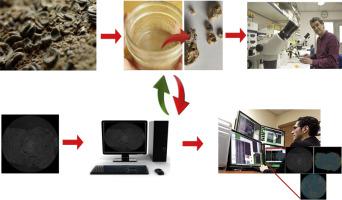当前位置:
X-MOL 学术
›
Mar. Micropaleontol.
›
论文详情
Our official English website, www.x-mol.net, welcomes your feedback! (Note: you will need to create a separate account there.)
Automated Microfossil Identification and Segmentation using a Deep Learning Approach
Marine Micropaleontology ( IF 1.9 ) Pub Date : 2020-06-01 , DOI: 10.1016/j.marmicro.2020.101890 L.E. Carvalho , G. Fauth , S. Baecker Fauth , G. Krahl , A.C. Moreira , C.P. Fernandes , A. von Wangenheim
Marine Micropaleontology ( IF 1.9 ) Pub Date : 2020-06-01 , DOI: 10.1016/j.marmicro.2020.101890 L.E. Carvalho , G. Fauth , S. Baecker Fauth , G. Krahl , A.C. Moreira , C.P. Fernandes , A. von Wangenheim

|
Abstract Computational analysis applicability to paleontological images ranges from the study of the evolution of animals, plants and microorganisms to the habitat simulation of living beings from a specific epoch. It can also be applied in several niches, e.g. oil exploration, where several factors can be analyzed in order to minimize costs related to oil extraction. One specific factor is the characterization of the environment to be explored. This analysis can occur in several ways: use of probes, samples extraction, correlation with logs of other drilling wells and so on. During the samples extraction phase, the Computed Tomography (CT) is of extreme importance, since it preserves the sample and makes it available for several analyses. Based on 3D images generated by CT, analyses and simulations can be performed, and processes currently performed manually and exhaustively, can be automated. In this work, we propose and validate a method for fully automated microfossil identification and segmentation. A pipeline is proposed that begins with scanning and ends with the microfossil segmentation process. For the microfossil segmentation, a Deep Learning approach was developed, which resulted in a high rate of correct microfossil segmentation (98% IOU). The validation was performed both through an automated quantitative analysis and visual inspection. The study was performed on a limited dataset, but the results provide evidence that our approach has potential to be generalized to other carbonatic rock substrates. To the extent of the authors' knowledge, this paper presents the first fully annotated MicroCT acquired microfossils dataset made publicly available.
中文翻译:

使用深度学习方法自动识别和分割微化石
摘要 古生物学图像的计算分析适用范围从动物、植物和微生物的进化研究到特定时代生物的栖息地模拟。它还可以应用于多个领域,例如石油勘探,其中可以分析多个因素以最小化与石油开采相关的成本。一个特定因素是要探索的环境的特征。这种分析可以通过多种方式进行:探针的使用、样品提取、与其他钻井记录的相关性等。在样品提取阶段,计算机断层扫描 (CT) 非常重要,因为它可以保存样品并使其可用于多次分析。基于CT生成的3D图像,可以进行分析和模拟,目前手动和彻底执行的流程可以自动化。在这项工作中,我们提出并验证了一种全自动微化石识别和分割的方法。提出了一种以扫描开始并以微化石分割过程结束的管道。对于微化石分割,开发了一种深度学习方法,导致微化石分割的正确率很高(98% IOU)。验证通过自动定量分析和目视检查进行。该研究是在有限的数据集上进行的,但结果证明我们的方法有可能推广到其他碳酸盐岩基质。就作者所知,
更新日期:2020-06-01
中文翻译:

使用深度学习方法自动识别和分割微化石
摘要 古生物学图像的计算分析适用范围从动物、植物和微生物的进化研究到特定时代生物的栖息地模拟。它还可以应用于多个领域,例如石油勘探,其中可以分析多个因素以最小化与石油开采相关的成本。一个特定因素是要探索的环境的特征。这种分析可以通过多种方式进行:探针的使用、样品提取、与其他钻井记录的相关性等。在样品提取阶段,计算机断层扫描 (CT) 非常重要,因为它可以保存样品并使其可用于多次分析。基于CT生成的3D图像,可以进行分析和模拟,目前手动和彻底执行的流程可以自动化。在这项工作中,我们提出并验证了一种全自动微化石识别和分割的方法。提出了一种以扫描开始并以微化石分割过程结束的管道。对于微化石分割,开发了一种深度学习方法,导致微化石分割的正确率很高(98% IOU)。验证通过自动定量分析和目视检查进行。该研究是在有限的数据集上进行的,但结果证明我们的方法有可能推广到其他碳酸盐岩基质。就作者所知,



























 京公网安备 11010802027423号
京公网安备 11010802027423号